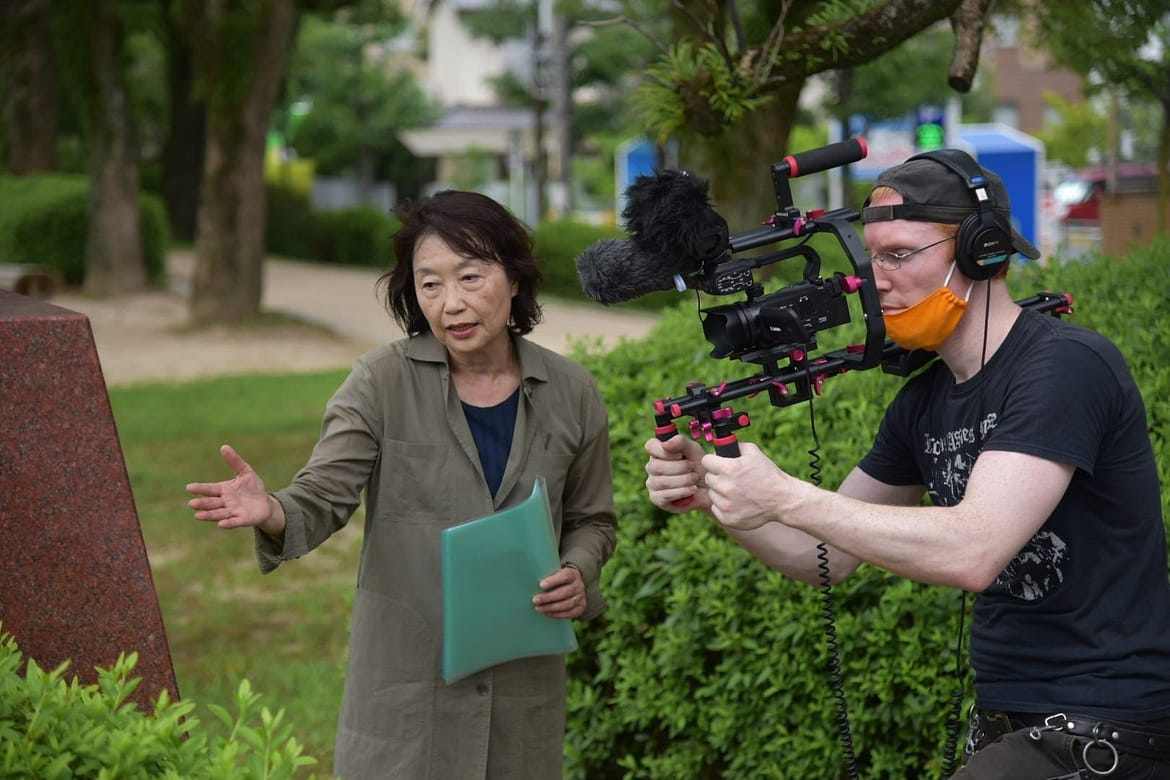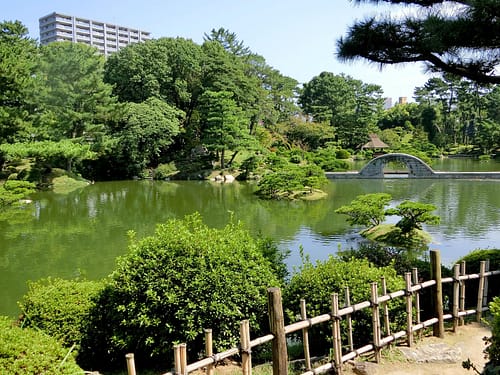HIP has provided free English tours of the monuments and landmarks in the Peace Memorial Park for foreign visitors since 1984. Through the “story-telling” guide of each memorial, many of our guests expressed their renewed desire for world peace. We’ve also received many questions during the tours about the monuments’ and their profound history. Here we would like to introduce some of these questions and our answers.
Q: Why was Hiroshima chosen for the first atomic bombing in human history?
As the United States began studying target cities for the atomic bomb, the Target Committee used criteria such as:
- The size of the city’s urban area being at least three miles in diameter (about 4.8 km)
- Whether topography would increase the blast damage
- Strategic significance to the Japanese war effort
- No known P.O.W. (prisoners of war) camps for Allied soldiers
The US shortened the list of potential cities to Hiroshima, Kokura, and Nagasaki. On August 2, the United States issued an order naming Hiroshima as the primary target.
Q: What was the target point for the atomic bombing?
The target point was the Aioi Bridge located at the center of Hiroshima city.
Q: Was the Aioi Bridge destroyed by the shock wave of the atomic bomb?
The shock wave from the blast bent the girders of the bridge and threw the handrail on the north side into the river. Blast forces reflecting off the surface of the river blew parts of the concrete sidewalk upward. Following restoration work, the bridge remained in use until 1982.
Q: How many people were killed by the atomic bomb?
The exact number of the dead remains uncertain, but the City’s official estimate states that 140,000 people died by the end of 1945.
Q: Is the radiation in Hiroshima at a safe level?
Yes, it is. Every place in the world has some ambient radioactivity (called “background radiation”). The background radiation in Hiroshima today is the same as any other place in the world. It is not a threat to human health.
Q: Did anyone try to help the A-bomb victims in Hiroshima?
Yes. Surviving military personnel (such as troops attached to the Army Marine Regiment Headquarters), police officers, and doctors started their rescue activities on the day of the atomic bombing. These rescue workers set up temporary first-aid stations along the riverbanks. They also used schools, a department store, and other surviving buildings to aid the wounded.
People from the surrounding towns and villages also rushed to help the victims. However, many victims could not receive adequate medical treatment because of supply shortages.
Q: What is the A-bomb Dome?
The A-bomb Dome is the atomic ruins of a building designed by Czech architect Jan Letzel. It first opened in 1915 as the Hiroshima Prefectural Commercial Exhibition Hall. The hall was a beautiful building which displayed and sold products from Hiroshima Prefecture, and hosted cultural events and art exhibitions. It also provided administrative services such as research and consultation on commerce and industry. Government agencies set up office in the building in 1944, the last period of the war.
Q: Why didn’t the A-Bomb Dome collapse despite being so close to the hypocenter?
Because the blast of the atomic bomb came from almost directly above, the intense heat melted the copper roof, and the tremendous shockwave pushed through the structure and out the windows, leaving most of the frame intact.
Q: Is the A-Bomb Dome in the same condition today as it was at the time of the atomic bombing?
For the most part, yes. Hiroshima City has carried out preservation that maintains the original A-bombed condition of the Dome as much as possible. The first preservation work was completed in 1967, followed by four other efforts, the most recent in 2020. This painstaking work involves steel reinforcement, repair of cracks, and protection against rainwater and earthquake to ensure that the Dome will stand as a testament to the bombing for all time.
Q: How many buildings that survived the A-bombing still exist today?
The atomic bomb destroyed or severely damaged approximately 90% of the buildings within Hiroshima City. But within a radius of five kilometers from the hypocenter, 86 A-bombed buildings, including the A-Bomb Dome, remain as of November 1st, 2020.
Q: What is the significance of paper cranes?
The crane is a symbol of luck in Japan. It is said that folding a thousand paper cranes will make wishes come true. Even before WWII, Japanese people folded paper cranes wishing for recovery from disease or for good luck.
Q: Why do people donate paper cranes to the Peace Memorial Park?
The paper crane became a symbol of peace because of a young A-bomb survivor named Sadako Sasaki. Sadako developed leukemia ten years after the bombing due to radiation exposure on August 6th, 1945. She folded 1,000 paper cranes on her hospital bed with the wish to become well. Although Sadako died of her illness, her friends campaigned to build a monument in her honor. Their efforts gained international attention and forever linked the origami crane with the struggle for world peace. The Children’s Peace Monument which they campaigned to build still stands in the Peace Memorial Park today. Every year, school children from across Japan, and people from around the world, donate paper cranes to the Peace Park to symbolize their commitment to building a world free from war. These days, Peace Memorial Park receives around 10 metric tons of paper cranes each year — more than the weight of the Hiroshima and Nagasaki atom bombs combined.
Q: What happens to paper cranes donated to the Peace Memorial Park?
The City of Hiroshima used to burn them ceremonially. But in 2002 they started preserving them for longer. Since 2012, the City has distributed donated paper cranes for free to individuals and organizations. As a result, cranes donated to Hiroshima are displayed anew in peace events at home and abroad. They’re also recycled into business cards, origami paper, postcards, and more. Since 2015, all of Hiroshima’s municipal kindergartens and schools print their certificates of completion on paper made from recycled cranes.
Q: What is the Cenotaph for the A-Bomb Victims?
The Cenotaph is the first official memorial monument built in Hiroshima for the victims of the atomic bombing. Children orphaned by the A-bomb unveiled it on August 6th, 1952. Due to US censorship, the people of Hiroshima and Nagasaki had to wait until after the occupation ended to build memorials for the A-bomb victims. Because of deterioration, the City rebuilt the original concrete Cenotaph in granite in 1985.
Q: Were Japanese people the only victims of the atomic bombing in Hiroshima?
Actually, no. Tens of thousands of Koreans lived in Hiroshima at the time of the bombing. There were also Chinese residents, American P.O.W.s, German priests, students from South East Asia, and so on. All of them suffered the same horrors as the Japanese victims on August 6th, 1945.
Q: Why were there so many Korean victims?
Japan colonized Korea in 1910, and many Koreans who had lost their livelihood came to Japan seeking jobs. In addition, the Japanese government brought many Koreans to Japan against their will to bolster labor shortages during WWII. According to research by the Korean Hibakusha Association, around 50,000 Koreans lived in Hiroshima City at the time of the atomic bombing. Around 30,000 died.
Q: Are there monuments to any of the foreign victims of the A-bomb?
Yes. The Monument in Memory of the Korean Victims of the A-bomb stands on the west side of Peace Memorial Park. Other monuments exist outside the park. The Monument of Konan-ryo stands on the site of a dormitory for Special Southeast Asian Students*. The City also built a plaque for the 12 American P.O.W.s killed by the atomic bomb.
*(Special Southeast Asian Students were the first Japanese-government-sponsored foreign students brought to Japan from occupied territories in Southeast Asia during the Pacific War.)

